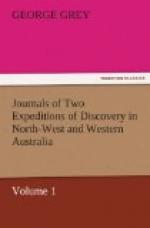BEAUTY OF THE BIRDS.
The birds of this country possess in many instances an excessively beautiful plumage; and he alone who has traversed these wild and romantic regions, who has beheld a flock of many-coloured parakeets sweeping like a moving rainbow through the air whilst the rocks and dells resounded with their playful cries, can form any adequate idea of the scenes that there burst on the eyes of the wondering naturalist.
The beginning of the month of February, or the end of January, is the season in which the birds in these parts pair. In the beginning of March I found many nests with eggs in them; and in the end of that month eggs nearly hatched were observed in most of the nests, as well as young birds occasionally.
RAPACIOUS BIRDS.
Of rapacious birds I saw but four kinds, but these are by no means common:
The first species was a very large bird, of a dark colour (Aquila fucosa, Cuvier) in size, appearance, and flight closely resembling the golden eagle which I have often seen, and have once shot on the north-west coast of Ireland. I have approached these birds closely—so closely indeed that I have on two occasions shot them, but each time they fell into a thick mangrove inlet and I was not fortunate enough to procure either of them; they appeared to me always to frequent the shores, for I never saw them further inland than a mile from the sea. The large nests Captain King mentions as having been found upon the coast I imagine must have belonged to this species.
The second species was a sort of hawk (Haliaeetus leucosternus, Gould) rather larger than the sparrow-hawk, of a light cinnamon colour, with a perfectly white head. They also frequent the shores, but I never shot one.
The third species was a Peregrine falcon (Falco melanogenys, Gould) which is nearly allied to that of Europe. I was not fortunate enough to procure a specimen of this bird.
The fourth was the Athene Boobook. Belly brown and white; wings brown, with white spots; third quill-feather, longest; legs feathered, lightish brown colour; tail brownish white, marked with transverse bars of a darker brown; eye prominent; iris blue. The only difference I could observe between the male and female is that the female is rather larger than the male, and her colours somewhat lighter. These birds inhabit the whole of that part of North-western Australia lying between the Prince Regent and Glenelg Rivers, and probably may be distributed over the greater portion of the Continent. They feed on insects, reptiles, and birds of the smaller kind. I have always found them seated in holes in the rocks, or in shady dells, and have never seen them fly in the daytime unless compelled by fear; they are very stupid when disturbed, and in flight and manner closely resemble the common English owl. I cannot however recollect having ever seen one on the wing during the night.
Upon describing the two singular birds mentioned above in Chapter 9 to Mr. Gould he informed me that they were most probably of the rare species Anas semipalmata.




